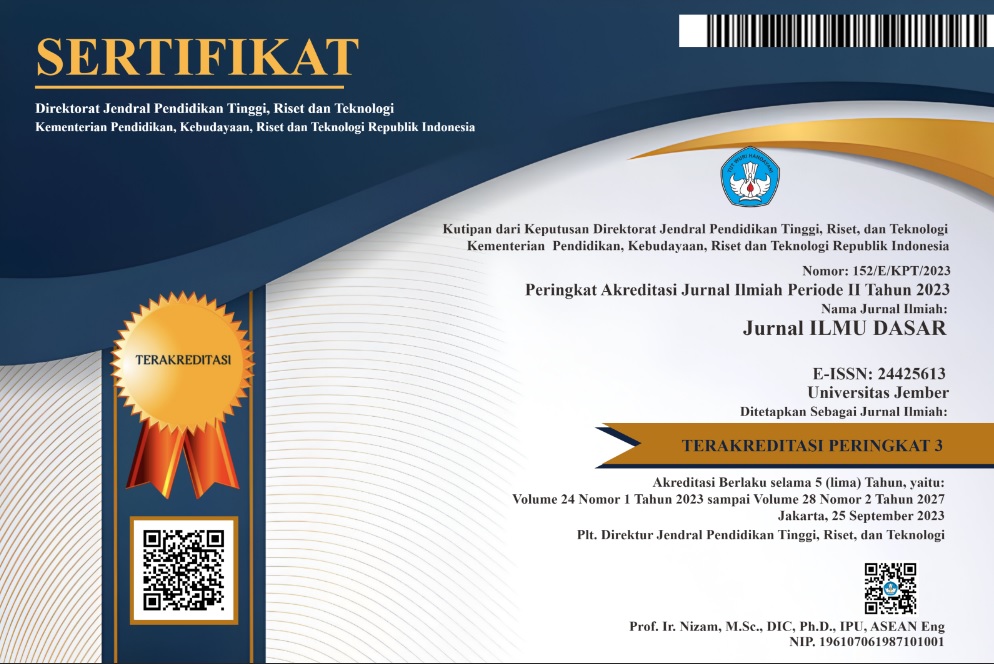Flooded Area Mapping and Its Relationship to the Land Use, Soil Type, and Rainfall in North Konawe Regency
DOI:
https://doi.org/10.19184/jid.v23i2.23898Keywords:
flood distribution, sentinel-1, land use, rainfall, soilAbstract
The flood incident in North Konawe Regency, Southeast Sulawesi that occurred on June 2nd, 2019 was the largest flood disaster in that area since the last 42 years, so it is interesting to study. As part of disaster risk management, it is necessary to do flood mapping to determine the distribution of flooded areas and identify areas that have potential for flooding. Mapping of flood inundation areas was carried out using Sentinel-1 data. Land use, rainfall and soil types are used as an analysis of their were relationship to the distribution of flood. The distribution of flood based on the identification of the presence of inundation covered 3 sub-districts, namely Oheo District, Asera District and Andowia District. Correlation of flood distribution to the land use, rainfall and soil type was identified using Pearson correlation value (r). The correlation between flood distribution and land use was -0.59 that indicates the correlation is moderate. Moreover, the correlation of flood distribution to the rainfall was 0 which means the correlation was very weak, and lastly, the correlation value of the flood distribution with soil type was 0.88 or the correlation was very strong.
Downloads
References
Asdak C. 1995. Hidrologi dan Pengolahan Daerah Aliran Sungai Yogyakarta: Gadjah Mada University Press.
Budianto L. 2019. Mencari Solusi Banjir Bandang di Sulawesi Tenggara. https://kumparan.com/kendarinesia/mencari-solusi-banjir-bandang-di-sulawesi-tenggara-1rMZVBN6mb0/full. [25 Juni 2020].
Cahyono BE, Cahyatri P, Purwandari E, Misto & Febrianti, N. 2021. Mapping Flooded Risk Area in East Java Indonesia Using Remote Sensing Data. Journal of Physics: Conference Series (IoP). 1825(012081): 1-9.
Dao PD, Liou Y-A & Chou C-W. 2015. Detection of Flood Inundation Regions with Landsat/MODIS Synthetic Data, Proceedings of International Symposium on Remote Sensing at Taiwan.
Darmawan K, Hani’ah & Supriyogi A. 2017. Analisis Tingkat Kerawanan Banjir di Kabupaten Sampang Menggunakan Metode Overlay dengan Scoring Berbasis Sistem Informasi Geografis. Jurnal Geodesi UNDIP. 6(1): 31-40.
Dhakal AS, Amada T, Aniya M. & Sharma R. R. 2002. Detection of Areas Associated with Flood and Erosion Caused by a Heavy Rainfall Using Multitemporal Landsat TMDat. Photogrammetric Engineering and Remote Sensing. 68(3): 233-239.
Eberhardt ID, Schultz B, Rizzi R, Sanches ID, Formaggio AR, Atzberger C, Mello MP, Immitzer M, Trabaquini K, Foschiera W & José Barreto Luiz A. 2016. Cloud Cover Assessment for Operational Crop Monitoring Systems in Tropical Areas. Remote Sensing. 8(3).
Feng Q, Liu J & Gong J. 2015. Urban Flood Mapping Based on Unmanned Aerial Vehicle Remote Sensing and Random Forest Classifier-A Case of Yuyao, China. Water. 7(4).
Harto S. 1993. Analisis Hidrologi Jakarta: Gramedia Pustaka Utama.
Ibeje AO, Osuagwu JC & Onosakponome OR. 2018. Impacts of Land Use on Infiltration. World Journal of Engineering Research and Technology. 4(6): 95-102.
Kirkham MB. 2014. Principles of Soil and Plant Water Relations. 2nd Ed. Manhattan, USA: Academic Press.
Kwak Y, Arifuzzanman B & Iwami Y. 2015. Prompt Proxy Mapping of Flood Damaged Rice Fields Using MODIS-Derived Indices. Remote Sensing. 7(12): 15969-15988.
Mason DC, Dance SL & Cloke HL. 2021. Floodwater Detection in Urban Areas Using Sentinel-1 and World DEM Data. Journal of Applied Remote Sensing. 15(3): 032003.
Moharrami M, Javanbakht, M & Attarchi S. 2021. Automatic Flood Detection Using Sentinel-1 Images on the Google Earth Engine. Environmental Monitoring and Assessment. 193(5): 248.
Morissan. 2016. Statistika Sosial Jakarta: Kencana.
Polamuri S. 2017. How Random Forest Algorithm Works In Machine Learning. https://dataaspirant.com/random-forest-algorithm-machine-learing/. [21 Juni 2021].
Romero BR, Hirpa FA, Pozo JT, Salamon P, Brakenridge R, Pappenberger F & Groeve, TD. 2015. On the Use of Global Flood Forecasts and Satellite-Derived Inundation Maps for Flood Monitoring in Data-Sparse Regions. Remote Sensing. 7(11).
Schumann GJP. 2015. Preface: Remote Sensing in Flood Monitoring and Management. Remote Sensing. 7(12).
Shahabi H, Shirzadi A, Ghaderi K, Omidvar E, Al-Ansari N, Clague JJ, Geertsema M, Khosravi K, Amini A, Bahrami S, Rahmati O, Habibi K, Mohammadi A, Nguyen H, Melesse AM, Ahmad BB & Ahmad A. 2020. Flood Detection and Susceptibility Mapping Using Sentinel-1 Remote Sensing Data and a Machine Learning Approach: Hybrid Intelligence of Bagging Ensemble Based on K-Nearest Neighbor Classifier. Remote Sensing. 12(2): 1-30.
Tahsin S, Medeiros SC, Hooshyar M & Singh A. 2017. Optical Cloud Pixel Recovery via Machine Learning. Remote Sensing. 9(6): 1-19.
Zhang M, Chen F, Liang D, Tian, B. & Yang, A. 2020. Use of Sentinel-1 GRD SAR Images to Delineate Flood Extent in Pakistan. Sustainability. 12(5784): 1-19.
Zufrizal. 2021. 1.205 Bencana Alam Terjadi Selama 1 Januari-30 April 2021. https://kabar24.bisnis.com/read/20210501/15/1389038/bnpb-1205-bencana-alam-terjadi-selama-1-januari-30-april-2021. [21 Juni 2021].








